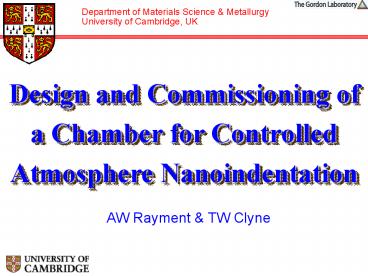AW Rayment PowerPoint PPT Presentation
1 / 21
Title: AW Rayment
1
Department of Materials Science
Metallurgy University of Cambridge, UK
Design and Commissioning of a Chamber for
Controlled Atmosphere Nanoindentation
AW Rayment TW Clyne
2
Talk Outline
- Motivations for Approaches to Controlled
Atmosphere Indentation
- High Temperature Oxidation Problems -
Thermodynamics
- High Temperature Oxidation Problems - Kinetics
- Design and Characteristics of a Controlled
Atmosphere System
3
Stability Problems with Indentation in Air
- At High Temperatures, Indenter (Diamond) may
Oxidise (Erode). Products Gaseous, so expect
Constant Erosion Rate. Tips can become Blunted
and Tip Life may be Short.
- At High Temperatures, Specimens may Oxidise.
Products usually Solid, so Rate will probably
decrease with Time. Products likely to Interfere
with Indentation, even when Thin.
- At Low Temperatures (below Ambient), Strong
Tendency for Condensation in Vicinity of
Specimen. Likely to Inhibit reliable Indentation.
- Due to Need for Mechanical Access to Specimen,
via Delicate Sensors, Very Difficult to Avoid
these Problems by Isolation Shrouding with
Inert Gas, use of Dessicants etc.
4
Talk Outline
- Motivations for Approaches to Controlled
Atmosphere Indentation
- High Temperature Oxidation Problems -
Thermodynamics
- High Temperature Oxidation Problems - Kinetics
- Design and Characteristics of a Controlled
Atmosphere System
5
Ellingham Diagram for Oxidation of Carbon Nickel
At 1 atm pressure, large negative free energy
changes for oxidation of C Ni ( other metals),
over the complete T range, so these reactions are
strongly favoured thermodynamically
6
O2 Partial Pressures to Avoid Oxidation of Carbon
Nickel
- ?G ?G0 RT ln(K)
- K 1 / p(O2)
- for ?G 0,
- p(O2) exp(?G0/RT)
O2 partial pressures necessary for these
reactions to become thermodynamically
unfavourable are in general below the achievable
range
7
Talk Outline
- Motivations for Approaches to Controlled
Atmosphere Indentation
- High Temperature Oxidation Problems -
Thermodynamics
- High Temperature Oxidation Problems - Kinetics
- Design and Characteristics of a Controlled
Atmosphere System
8
Reported Erosion Rates for Diamond
Readily achievable O2 pressures (10-5 bar) bring
erosion rates down to acceptable levels (lt0.1 ?m
min-1), even at high T (1000C). Argon (for
back-filling to 1 atm) typically contains about
10 ppm of O2 (partial pressure of 10-5 bar).
9
Reported Oxidation Rates for Nickel
Growth rate exhibits parabolic kinetics,
After 1 hour at 1000C, oxide thickness is
several µm at 1 bar of O2, whereas at 10-6 bar it
is a small fraction of a µm.
10
Talk Outline
- Motivations for Approaches to Controlled
Atmosphere Indentation
- High Temperature Oxidation Problems -
Thermodynamics
- High Temperature Oxidation Problems - Kinetics
- Design and Characteristics of a Controlled
Atmosphere System
11
Chamber Dimensions and Specifications
Plan
Enclosed volume 1 m3 Total chamber mass 1
tonne Pneumatic actuator struts for lid lifting
Elevation
12
Views of Chamber, with Nanoindenter in situ
Vibration-damped table inside chamber 12
separate electrical feedthroughs All Indenter
components vacuum-safe
13
Evacuation and Back-filling of the Chamber
Oxygen Monitor
Simple rotary pump for initial roughing High
speed turbo-molecular pump About one hour to
reach 10-6 bar Deflection of evacuated
chamber base lt 1 mm Double O-rings for reduced
leakage rates Indenter normally operated under
1 bar Ar Standard purity Ar has 5-30 ppm
oxygen Back-filling time 5 minutes
Turbo-molecular pump
14
Summary
- At high T (ie above 300-400C), oxidation of
diamond, possibly of (metallic) specimens, are
problematic
- The O2 partial pressures required to make such
reactions thermodynamically unfavourable are not
achievable
- However, p(O2) 10-5 bar (eg 10 ppm O2 in an
inert atmosphere), which is readily achievable in
a vacuum chamber, reduces rates of oxidation to
acceptable levels
- Problems of water condensation below ambient T
are also eliminated by use of a vacuum chamber
- A (vertical axis) chamber, recently designed
installed at Cambridge, now being commissioned
for nanoindentation, should therefore allow
operation over a wide range of T
15
Turbo pump limits
16
Turbo pump times
17
Schematic of the system
KF 40-25 adaptor /Oxygen sensor
Argon/air venting valve
LF-160 centre rings, o rings and clamps
T adaptor
LF160 for feedthroughs with blank
Indentor
Control system
420 RUG 160-160 CF-LF adaptor
Argon turbo brake valve
Argon supply
KF 40-25 adaptor Pressure sensor
Turbo pump CF 160
Chamber
LF-160 centre rings, o rings and clamps
CF-160 centre rings, o rings and clamps
Piping for Argon
Vent to outside
Exhaust trap
Back flow trap
Roughing pump Edwards
A Rayment July 2006
18
Working regions
10ppm etch rate lt0.1 um/min
19
(No Transcript)
20
(No Transcript)
21
(No Transcript)

